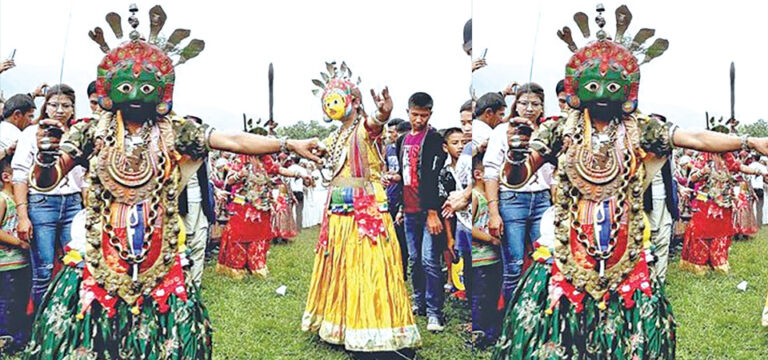
The residents of Khokana are currently busy preparing for the Sikali Jatra. Dedicated to goddesses Sikali and Rudrayani, the Jatra lasts for five days, starting from Tritiya, two days after Ghatasthapana, to Maha Asthami.
Celebrated with masked dances and feasts, this Jatra does not seem any more special than scores of other similar festivals celebrated all across the valley throughout the year. However, what makes Sikali Jatra exceptional is that it is celebrated during Dashain, instead of Dashain itself.
Unlike most other Hindus in the country and abroad, the villagers of Khokana do not celebrate Dashain. Instead, they celebrate Sikali in a grand manner. Before the festival begins, eight young boys, selected from the family of Guthi members, go to every household of Khokana to collect rice. They do this for four days, from Ekadashi to Chaturdashi.
“Meanwhile, a secret puja is performed in the temple of Goddess Sikali from Ghatasthapana to Chaturdashi, for which eight unmarried boys go to the temple, located a short distance away from village core,” said Hari Ram Dongol, Khokana local and treasurer of the Shree Khanda Sala Guthi. “Even a bird is not allowed to fly over the temple while the puja is performed.”
Dongol informed that the eight boys collect puja items from the homes of all the members of two Guthis – Ta Guthi and Shree Khanda Sala Guthi.
“The boys need to adhere to strict norms from Ghatasthapana to Kojagrat Purnima. They are not allowed to eat eggs, chicken and garlic, cannot drink alcohol and can only have one meal a day,” he added.
Panchami is the main day of the festival when the original idol of Rudrayani is taken out of its temple in the middle of the village and taken to the Sikali Temple on a wooden chariot. A grand Yagya is performed in the evening which continues into the next day.
A distinct feature of the Jatra is the masked dance performed by 14 individuals, called Devgans, dressed as 14 Hindu deities. Each step of the dance is drawn from centuries-old tantric rituals.
Some of the Devgans also walk over fire lit on the Sikali Temple premises as part of the religious dance.
The person leading the Guthi in a given year walks around the temple carrying a pot full of rice. This rice is then distributed to the devotees gathered to watch the ceremonies as Prasad. Consuming this Prasad is believed to cure stomach ailments.
The festival concludes when the idol of Rudrayani is reinstated in its temple on the day of Maha Ashtami.
Three different Guthis, Ta Guthi, Shree Khanda Sala Guthi and Jha: Guthi, manage all the rituals of the festival.
There are various legends that describe why the people of Khokana do not celebrate Dashain. A popular story has it that the residents of Kudesh in the area of present-day Sikali Temple were troubled by demons.
So terrorising were the demons that the citizens of Kudesh decided to move to the present-day Khokana square. While moving, they also brought their tutelary goddess and established her in the present-day Rudrayani Temple.
In the new location, a new date had to be fixed to celebrate the Sikali Jatra, which previously fell on Gai Jatra. That new date coincided with Dashain. So, the people chose to prioritise the Jatra over Dashain.
Source : TRN,






